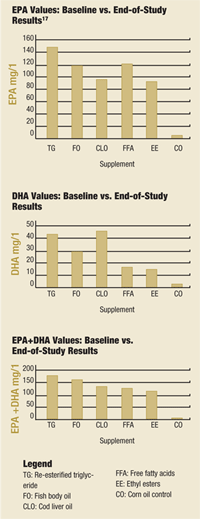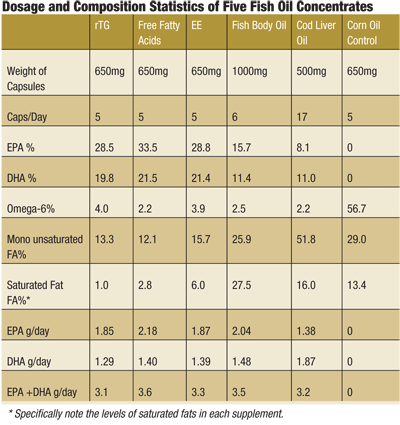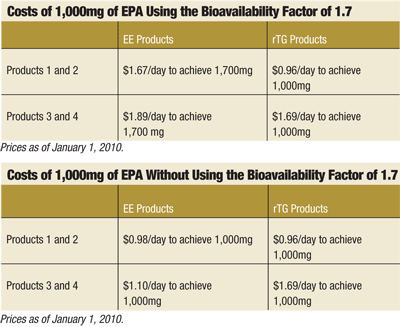It is estimated that the average American consumes between 100mg to 200mg of omega-3 fatty acids per day.1-3 Humans cannot naturally synthesize omega-3 fatty acids, so dietary consumption is nescessary.1,2
The majority of omega-3 fatty acid intake comes from alpha linolenic acid (ALA) sources, such as flaxseed oil. Unfortunately, conversion of ALA to the essential EPA and DHA forms is very inefficient.4 So, consumption of fish and fish oil is the most effective way to attain appropriate dietary levels of EPA and DHA. In spite of dramatic evidence regarding the health benefits of omega-3s from fish oil, the FDA has not officially established guidelines regarding its recommended daily allowance (RDA).
Several health-related issues associated with regular fish consumption have surfaced during the last five years, including the ingestion of fish that are caught in polluted streams, lakes and bays. Bottom-feeding coastal fish are more susceptible to contamination by chemicals and toxins than fish that feed at higher water levels. So, open-water, or pelagic, fish are the most ideal for human consumption.
Because of several underlying factors, including geographic location, income level or unconventional dietary preferences, frequent fish consumption is not a realistic option for everyone.
Fortunately, however, fish oil supplements have become a reasonable alternative to dietary fish intake.
 General Recommendations
General Recommendations
The American Heart Association (AHA) recognizes the benefits of omega-3 fatty acids. The AHA recommends that:5
• All adults eat fish (particularly fatty fish) at least two times a week. Fish is a good source of protein and is low in saturated fat. Fish, especially oily species like mackerel, lake trout, herring, sardines, albacore tuna and salmon, provide significant amounts EPA and DHA.
• Patients with documented coronary heart disease should receive one combined gram of EPA and DHA per day. This may be obtained from the consumption of oily fish or from omega-3 fatty acid capsules.
• An EPA/DHA supplement may be useful in patients with hypertriglyceridemia. Two to four grams of EPA/DHA per day can lower an individual’s triglycerides by 20% to 40%.
Just remember, patients who take more than three combined grams of EPA and DHA per day should consult a physician about potential side effects, such as gastrointestinal distress.
Fish Oil Fundamentals
Because of the potential for pollutant contamination, fish oil must be distilled and pasteurized. Here is a general overview of the distillation process:6
1. Crude fish oil (many different variations) is altered with ethanol.
2. This mixture is then heat-distilled under a vacuum to remove contaminants.
3. The resultant liquid contains concentrated omega-3 molecules in an ethyl ester package.
4. The liquid is then manipulated to closer simulate a natural long-chain omega-3 fatty acid composition.
During the distillation process, the raw fish oil is broken down, cleansed, then reformulated into two basic products––ethyl ester (EE) and triglyceride (TG). The body recognizes both products and utilizes specific enzymes to create an absorbable form of the omega-3 fatty acid. The rudimentary purpose of the distillation process is to create a supplement that demonstrates:
• Safety and tolerability.
• High concentrations of EPA and DHA with minimal side effects.
• Optimal bioavailability.
• Overall stability.
• Affordability.
Triglycerides vs. Ethyl Esters
• Triglycerides. TGs are the molecular form of dietary fats that are found in most foods. In fact, the omega-3 fats found in all species of fish are exclusively TGs.7 TGs are comprised of three fatty acids that are linked to a molecule of glycerol. Because fatty acids are rapidly oxidized or highly unstable, the glycerol backbone helps to stabilize the fat molecules and prevent breakdown and oxidation.8
• Ethyl esters. EEs are synthetically derived by reacting fatty acids with ethanol to create an alternate form of fat.9 These alternative fats are created during the processing of some fish oils. In this case, natural fatty acids are cleaved from their glycerol backbone and linked to a molecule of ethanol––a process known as esterification.10 Following esterification, the fats contain higher concentrations of EPA and DHA than before processing. The resultant semi-synthetic EE product is then commonly sold as omega-3 fish oil concentrate.9
To effectively create TG fish oil, however, the distilled EEs must be re-esterified to remove the ethanol backbone and reestablish a glycerol backbone, which adds to the cost of production. Fortunately, in most cases, manufacturers will indicate if their fish oil capsules are either TG- or EE-based.
Metabolism of Fatty Acids
So, which form of fish oil offers the highest level of bioavailability? To answer this question, we must first assess the physiology of absorption and metabolism of TGs and EEs.
• TG fish oil. Re-esterified TG (rTG) fish oils are digested in the small intestine by the emulsifying action of bile salts and the hydrolytic activity of pancreatic lipase. This process leaves two fatty acids and a monoglyceride in the intestinal fluid, which are absorbed when combined with bile acids. The fatty acids and monoglycerides form complexes with bile salts called micelles. Absorbed within the enterocyte (intestinal cells) of the small intestine, the micelles are packaged with cholesterol and lipoproteins to form chylomicrons. Next, the chylomicrons move to the lymph system, where they enter the bloodstream and are passed to the liver. From the liver, the chylomicrons are converted into very low-density lipoproteins (VLDL) and low-density lipoproteins (LDL) for tissue delivery via the circulatory system.7,11,12
• EE fish oil. Digestion of EE fish oils is slightly different, however, because they lack a glycerol backbone.7 In the small intestine, the pancreatic lipase hydrolyzes the fatty acids from the ethanol backbone; however, this fatty acid-ethanol bond is up to 50 times more resistant to pancreatic lipase than the acid-glycerol bond found in rTG fish oil. As a result, human metabolizing of EE fish oil is somewhat inefficient.7,13
When metabolized, EE fish oil produces free fatty acids (FFAs) as well as ethanol. The fatty acids are taken up by the enterocytes and must be reconverted to TGs to be effectively transported in the blood. Thus, EE fish oil requires a monoglyceride substrate from another naturally occurring source, whereas the rTG form contains its own substrate.
Research on Bioavailability
Numerous studies have assessed the absorption and bioavailability of both TG and EE fish oils by measuring the amount of EPA and DHA in the blood plasma after ingestion. Many of these studies have yielded conflicting, somewhat controversial information.
Two studies published in the early 1990s showed that absorption rates of EPA and DHA from both natural TG and EE fish oil sources were virtually identical.14,15 Then, in 1993, a similar study showed that EPA and DHA absorption from EE fish oil was comparable to that from natural TG; however, the TG variants delivered better bioavailability with a lower concentration of fatty acids.16
A more intensive study published in 1990 presented conflicting data from a randomized, triple cross-over trial that examined the bioavailability of EPA and DHA from TG fish oil, EE fish oil and FFAs.17 Compared to the TG form, the mean relative bioavailability of EPA/DHA measured 186%/136% from free fatty acids and 40%/48% from EE. When compared to the TG form, maximal plasma levels were 50% higher from free fatty acids and 50% lower from EE.
Additionally, data from a similar study published in 2003 reaffirmed that EPA and DHA absorbed from rTG salmon oil were more effectively incorporated into plasma lipids than EPA and DHA from EE fish oil capsules.18 In general, both studies suggested that TG fish oil demonstrated nearly twice as much overall bioavailability than EE fish oil.17,18
A major double-blinded, randomized, placebo-controlled study published in 1995 assessed the bioavailability of the five most common fish oil concentrates––rTG, EE, FFA, fish body oil (FBO) and cod liver oil (CLO).19 In this study, 72 healthy subjects received daily doses of one of the five fish oil preparations or a corn oil control supplement for two weeks. The researchers estimated that all subjects received an average of 3.34 g of EPA and DHA per day. (See “Dosage and Composition Statistics of Five Fish Oil Concentrates,” below.)

The patients were examined in the morning following an overnight fast at both baseline and two-week follow-up.
Under these testing conditions in a fasting state, the concentration of EPA+DHA was highest in the rTG group and lowest in the corn oil control group. The results showed that that the unadjusted mean relative bioavailability EPA+DHA was 73% from EE, 91% from FFA and 124% from rTG. After adjustment for dosage factors, the mean relative bioavailability was 76% from EE, 86% from FFA and 134% from rTG.
These results indicate that the absorption of EPA+DHA from rTG is 1.763 times higher than that from EE. Even more interesting, rTG performed better than naturally occurring TG from FBO and CLO supplements.19
Considerations for Optimal Absorption
Another bioavailability issue involves both how and when fish oil is consumed. For example, one study showed that just 20% of available EPA and DHA is absorbed from EE fish oil supplements––unless taken with a high-fat meal (a high-fat meal raised absorption to 60%).18
Likewise, rTG fish oil demonstrates varied absorption rates when consumed with high-fat meals. In one study, EPA absorption from rTG supplements increased from a base level of 69% to 90% when consumed with a high-fat meal; DHA absorption was unaffected.20
While this is compelling research, it is ill advised to regularly consume high-fat meals simply to increase omega-3 absorption. Nonetheless, these studies underscore the importance of taking a fish oil supplement during a meal rather than individually between meals.
Product Stability
Keep in mind that all fish oils are particularly susceptible to oxidation, which reduces the product’s stability and bioavailability. Because of this, vitamin E is often added as a natural preservative.21
In general, fish oil has a six-month shelf life. In fact, an overly fishy taste is one indication of age-related oxidation. Sometimes, an enteric coating may mask this fishy taste.
According to one report, DHA from EE fish oils was much less stable than DHA from rTG fish oils.22 Specifically, the study indicated that DHA from EE fish oil was more reactive and quickly oxidized, suggesting that expired EE fish oils could more readily produce harmful oxidative products.22
Another study compared the stability of DHA in phospholipid, triacylglycerol and EE fish oils. After a 10-week oxidation period, DHA from EE fish oil decayed 33% more rapidly than DHA from the other two fish oils.23
 The Economics of Fish Oil Supplementation
The Economics of Fish Oil Supplementation
Many clinicians and patients have raised the point that rTG fish oil is more expensive than EE fish oil. This could be attributed to the extra costs involved in re-esterifying EE fish oil back to TG. While this may be true, we have to consider absolute costs, because rTG fish oil is absorbed significantly better than EE fish oil.
Let us assume that we want a patient to take 1,000mg of EPA. If we employ the previously outlined human absorption statistics, this patient would experience 134% bioavailability from rTG fish oil and 76% bioavailability from EE fish oil. In other words, rTG fish oil has a 1.7 times higher bioavailability factor than EE fish oil.
So, our patient would actually have to consume 1,700mg of EPA from EE fish oil supplements to achieve his target intake of 1,000mg.
From an economics standpoint, you can easily compare the prices of several commercially available fish oil products. (See “Costs of 1,000mg of EPA Using the Bioavailability Factor of 1.7” and “Costs of 1,000Mg of EPA Without Using the Bioavailability Factor of 1.7,” left.)
When adjusted for the bioavailability factor of 1.7, there is no great cost difference between products 1, 3 and 4. Without question, the most economical supplement in both assessments is product 2––optimal absorption levels at the lowest overall cost.
The bottom line––either with or without adjusting for the bioavailability factor, you should assume some role in determining the highest level of bioavailability at the most affordable price for your patients.
Essential fatty acids, such as EPA and DHA, are critical to the maintenance of health. However, most diets are woefully low in long-chain omega-3 fatty acids. Therefore, many individuals could benefit tremendously from eating more foods rich in omega-3s or supplementing with fish oil capsules.
Just remember, not all fish oil supplements are created equal. By and large, the literature suggests that natural TG or rTG fish delivers higher concentrations of EPA and DHA than EE fish oil. However, several other factors, such as patient safety, product stability and affordability, should also be considered when selecting a fish oil supplement.
Dr. Alexander is the senior director of education development for Optovue, Inc., the ophthalmic digital imagining company. He is not a paid consultant for any pharmaceutical or nutraceutical companies.
1. Ervin RB, Wright JD, Wang CY, Kennedy-Stephenson J. Dietary intake of fats and fatty acids for the United States population: 1999-2000. Adv Data. 2004 Nov 8;(348):1-6.
2. Wang CM, Lichtenstein A, Balk E, et al. Evidence report/technology assessment no. 94. Effects of omega-3 fatty acids on cardiovascular disease. Rockville, Md.: The Agency for Healthcare Research and Quality; 2004.
3. Food and Nutrition Board, Institute of Medicine. Dietary Fats: Total Fat and Fatty Acids: Dietary Reference Intakes for Energy, Carbohydrate, Fiber, Fat, Fatty Acids, Cholesterol, Protein and Amino Acids. Washington: National Academies Press; 2002:422-541.
4. Ackman RG. The absorption of fish oils and concentrates. Lipids. 1992 Nov;27(11):858-62.
5. Kris-Etherton PM, Harris WS, Appel LJ. Omega-3 fatty acids and cardiovascular disease: new recommendations from the American Heart Association. Arterioscler Thromb Vasc Biol. 2003 Feb 1;23(2):151-2.
6. Dyerberg J, Bang HO, Stoffersen E, et al. Eicosapentaenoic acid and prevention of thrombosis and atherosclerosis? Lancet. 1978 Jul 15;2(8081):117-9.
7. Carlier H, Bernard A, Caselli C. Digestion and absorption of polyunsaturated fatty acids. Reprod Nutr Dev. 1991;31(5):475-500.
8. Segura R. Preparation of fatty acid methyl esters by direct reesterification of lipids with aluminum chloride methanol. J Chromatogr. 1988 May 27;441(1):99-113.
9. Saghir M, Werner J, Laposata M. Rapid in vivo hydrolysis of fatty acid ethyl esters, toxic nonoxidative ethanol metabolites. Am J Physiol. 1997 Jul;273(1 Pt 1):G184-90.
10. Mogelson S, Pieper SJ, Lange LG. Thermodynamic bases for fatty acid ethyl ester synthase catalyzed esterification of free fatty acid with ethanol and accumulation of fatty acid ethyl esters. Biochemistry. 1984 Aug 28;23(18):4082-7.
11. Favé G, Coste TC, Armand M. Physicochemical properties of lipids: New strategies to manage fatty acid bioavailability. Cell Mol Biol (Noisy-le-grand). 2004 Nov;50(7):815-31.
12. Lambert MS, Botham KM, Mayes PA. Modification of the fatty acid composition of dietary oils and fats on incorporation into chylomicrons and chylomicron remnants. Br J Nutr 1997;76:435-445.
13. Yang LY, Kuksis A, Myher JJ. Lipolysis of menhaden oil triacylglycerols and the corresponding fatty acid alkyl esters by pancreatic lipase in vitro: a reexamination. Br J Nutr. 1996 Sep;76(3):435-45.
14. Luley C, Wieland H, Gruwald J. Bioavailability of omega-3 fatty acids: ethylester preparations are as suitable as triglyceride preparations. Akt Ernaehr-Med 1990;15:122-125.
15. Nordøy A, Barstad L, Connor WE, Hatcher L. Absorption of the n-3 eicosapentaenoic and docosahexaenoic acids as ethyl esters and triglycerides by humans. Am J Clin Nutr. 1991 May;53(5):1185-90.
16. Krokan HE, Bjerve KS, Mørk E. The enteral bioavailability of eicosapentaenoic acid and docosahexaenoic acid is as good from ethyl esters as from glyceryl esters in spite of lower hydrolytic rates by pancreatic lipase in vitro. Biochim Biophys Acta. 1993 May 20;1168(1):59-67.
17. Beckermann B, Beneke M, Seitz I. Comparative bioavailability of eicosapentaenoic acid and docosahexaenoic acid from triglycerides, free fatty acids and ethyl esters in volunteers. Arzneimittelforschung. 1990 Jun;40(6):700-4.
18. Visioli F, Rise P, Barassi MC, et al, Dietary intake of fish vs. formulations leads to higher plasma concentrations of n-3 fatty acids. Lipids. 2003 Apr;38(4):415-8.
19. Dyerberg J, Madsen P, Moller J, et al. Bioavailability of n-3 Fatty Acid Formulations. In: N-3 Fatty Acids: Prevention and Treatment in Vascular Disease. London: Bi & Gi Publishers; 1995:217-26.
20. Lawson LD, Hughes BG. Absorption of eicosapentaenoic acid and docosahexaenoic acid from fish oil triacylglycerols or fish oil ethyl esters co-ingested with a high-fat meal. Biochem Biophys Res Commun. 1988 Apr 15;152(1):328-35.
21. Valk EE, Hornstra G. Relationship between vitamin E requirement and polyunsaturated fatty acid intake in man: a review. Int J Vitam Nutr Res. 2000 Mar;70(2):31-42.
22. Yoshii H, Furuta T, Siga H, et al. Autoxidation kinetic analysis of docosahexaenoic acid ethyl ester and docosahexaenoic triglyceride with oxygen sensor. Biosci Biotechnol Biochem. 2002 Apr;66(4):749-53.
23. Song JH, Inoue Y, Miyazawa T. Oxidative stability of docosahexaenoic acid-containing oils in the form of phospholipids, triacylglycerols, and ethyl esters. Biosci Biotechnol Biochem. 1997 Dec;61(12):2085-8.











